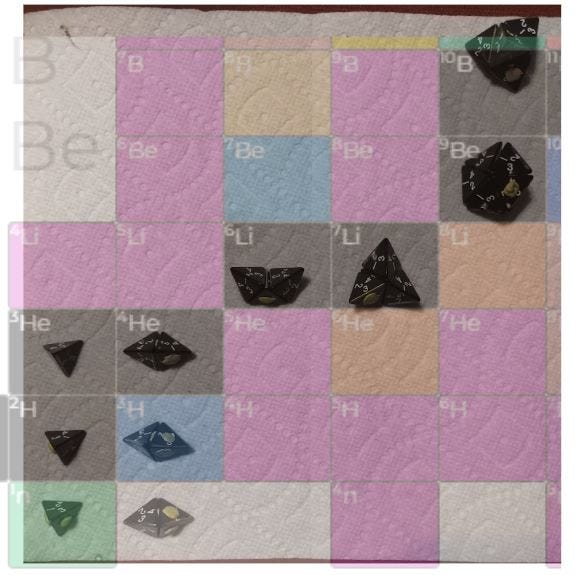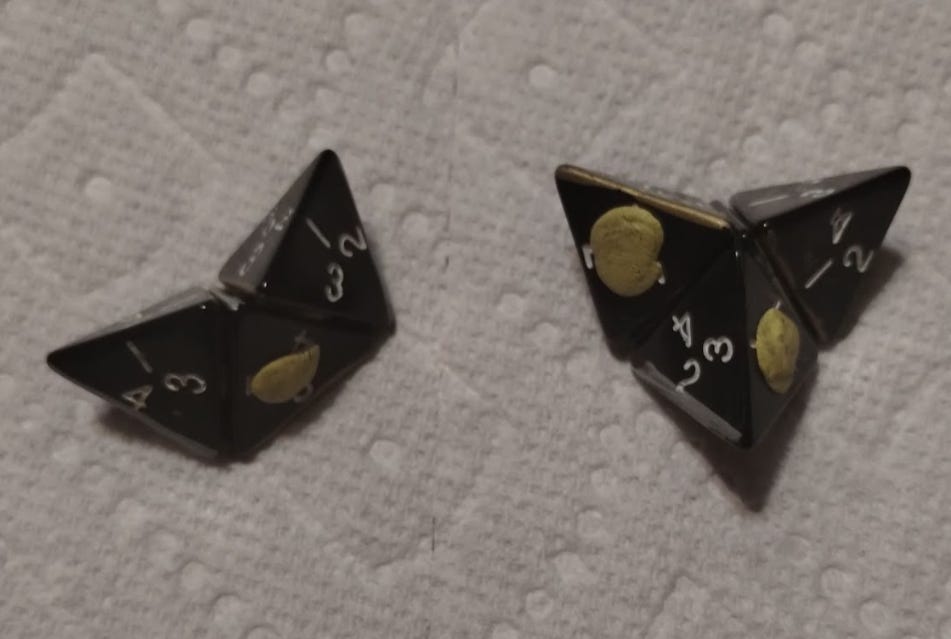I’d like to try to explain why the isotope Beryllium 8 is unstable, using the dice stuff.
A bit of a bold claim, but not without some good reason for puzzling about.
Historical ponderings about isotope stability have always had a bit of a sore spot in Be8, as you can add or subtract three deuteriums in either direction without any particular stability strangeness cropping up. WHAT GIVES?! It’s very counterintuitive. You can’t argue that it has too many/few protons/neutrons or whatever. It’s just an odd outlier.
Traditional explanations tend to lean on energetic favorability, the superstability of He4, not being a cluster or closed shell like He4, or even the *Magicness* of He4 because 2x2. This is all mostly copium, but people tend to not want to say such things in polite company - that’s for conferences and back room talk.
Clearly alpha particles are special, given that they’re a preferred thing for heavy isotopes to eject. Everyone wants to insert tetrahedra into their nuclear models (*sigh* I didn’t WANT to, I HAD to) and four little balls clumped up is what everyone likes to think of as He4. This is wrong, but understandable.
I would contend that Be8 is probably the prototypical ‘local condition’ for alpha decay, and it likely has relevance for larger isotopes (which I have been unable to access using a “diceotope” approach to date, but I just really got into the 2nd order spin considerations).
To start off with - none of this is going to make any sense if you haven’t gone back and reviewed some of my prior posts, both to understand some of my practical philosophy about nuclear and subatomic physics (it’s not deep or novel, it’s pragmatic), as well as the tetrahedral neutrons behavior underlying the reasoning here.
The knot stuff, as much as I would like to approximate it away using d4 dice, has some underlying details which must also be accounted for to make sense of what’s going on, so as to better account for proton locations and its magnetic ‘poles’. If this isn’t done, the argument for why Be8 is unstable isn’t so clear.
I realize that without going through prior isotopes in detail, it’s a bit of a leap to jump to why Be8 wouldn’t be stable, so I’m going to make sure to explain the “prototypical quadrant” first. Go read that here.
We are still covering this:
First, Lithium 6 & 7
I haven’t really mentioned Lithium yet much, only because it wasn’t time. It’s sort of hard to talk about Be8 without covering Lithium first.
Lithium 6 is a natural extension from He4, in that no rules are broken by adding a single Deuterium (1d4 with 1 negative facet). The D has several available options for attachment to the He4 core while respecting edge-alignment of the neutrons, which result in the same basic macrostate configuration down to this layer of resolution. Its possible that a third-order correction will establish further preference among the microstates.
A single negative facet/site is available on the surface of Li6 for other protons to attach to. An additional proton can be ‘temporarily’ accommodated by this structure (Be7 has a half life of ~53 days) using the available negative facet, but like other isotopes which violate the free-site rule, it is ultimately unstable.
Additional protons (B8, C9) cannot directly attach using electrical facet mechanisms, however the relative stability of these isotopes suggests that some degree of weak coupling is possible for short durations (perhaps between the neutron edges acting as magnetic poles and the proton’s own magnetic moment). This has not been discussed previously, as it appears to be a secondary stability mechanism not directly invoked (to this point) in stable configuration states. ALL of these isotopes are MORE stable than Be8. (that’s weird)
Li7
It is worth noting that Lithium is generally of low-abundance compared to other small isotopes, and the majority we observe is Li7. I would suggest this may imply that it is well-accommodated by other nuclei and gets incorporated in warm fusion reactions more than we realize.)
In the case of Be7, electron capture causes one of the surface protons to “pitch a tent”, converting to Li7 as the trefoil knot turns into a figure 8 knot (a bit of a mystery still, that). You can also think about Li7 as Li6 + n , the additional neutron can attach to Li6 either on the ‘back’ of the central neutron. (There is another possibility: thinking about it is as Li7 = He4 + H3, it could be that some resonance state is allowed, where the neutrons are co-planar and could be transitioning between two analogous modes. I don’t love this as a suggestion as it brings up more problems but it’s worth bearing in mind.
One could imagine that Li7 should theoretically have a configuration where a neutron might be caught in a double-negative (free space-like) condition, but this does not appear to occur. For those paying attention, you might ask how Li7 has two negative sites on its surface instead of one. (If so, you get a cookie!) The question of why Li7 isn’t unstable requires a deep dive into the details of available configuration states, and what is and isn’t happening to those 3 protons populating 5 negative sites, but only two. One should expect larger isotopes to accommodate additional negative surface sites/facets without violating stability rules at some size - but structural arguments are required.
Exhibiting two free sites is not sufficient to define instability. In the case of Tritium it works out that way, because the single proton can hop between 3 different sites and only 1 of those allows beta decay. In the case of Li7 (see above image) the central neutron is always stable. There are two possible configurations (without third order considerations) to this form which are the same except the north and south neutron poles (edge color) switches, depending on whether or not the free facet of the central neutron is positive or negative. This becomes important in the context of O16, which is like two Li7 nuclei (+2p), joined at this free site. O16 is then either using two halves with different ‘edge handedness’ to match +/- at this junction, or a proton is used and both halves share edge symmetry with a negative site on the exposed central facet. (this mechanism may be important later).
Considering a positive central site on Li7, the 5 available negative sites are occupied by 3 protons, and only 2 of the neutrons could be at risk of decay.
Considering a negative central site on Li7, the remaining 4 negative sites are occupied by 3 protons, and only 1 of the neutrons could be at risk of decay. Relative adjacency of hopping and the participation of the top/bottom dynamic in this structure remains unclear. Li7 will likely need some further analysis, but it presents no serious deal breakers.
One would like to argue that the negative central site is preferred for Li7, but further consideration is needed to argue that definitively. The tinkering continues - anyone is welcome to scoop me on how the third order details are set.
Back to Beryllium 8
Can you just stick a proton onto Li7? It has two available sites, it’s a “proto-star”.
Well, that’s a good question. Apparently you cannot. I think the specific reasons for that get back to a 3rd order spin pairing phenomena driving you toward di-neutrons, so it is admittedly a bit unclear presently why that configuration state isn’t available beyond that.
Since Be8 always spontaneously decays into two alpha/He4s, it is worth considering how these two identical structures interact when attempting to join them together. Focusing on He4, the underlying di-neutron means that there are only three sites (anti-holes?, “a-holes”?) which could remain unoccupied. The underlying structure of the di-neutron restricts the available ways to connect these two structures, leading to a “broken ring” promoting dissociation. An additional neutron stabilizes the ring, giving Be9.
So - the argument here is structural. You can probably tack on appeals to energy minimization and those sorts of arguments as we have done in the past, but the diceotope accounting mechanism gives a very direct insight into the local phenomena involved. For elements beyond Lead, the stability ladder is prone to alpha decay - one can expect local surface structures to resemble those of Be8, with additional subtlety brought on by the rest of the (as yet undetermined) structure.
Race you to Argon! Things get really weird around 20n - clearly.



